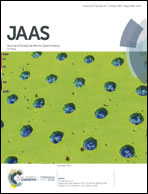Three-dimensional X-ray fluorescence imaging modes for biological specimens using a full-field energy dispersive CCD camera†
Abstract
Besides conventional scanning X-ray fluorescence imaging at synchrotron sources, full-field X-ray fluorescence (FF-XRF) imaging techniques that do not implicitly require spatial scanning of the sample have become available. FF-XRF has become achievable thanks to the development of a new type of energy dispersive CCD-based 2D detector, also referred to as a ‘color X-ray camera (CXC)’ or ‘SLcam’. We report on different imaging schemes for biological samples using FF-XRF imaging: (a) 2D ‘zoom’ imaging with pinhole optics using the ‘camera obscura’ principle; (b) 2D ‘fixed magnification’ imaging using magnifying polycapillary optics; and (c) 3D-FF-XRF imaging using an X-ray sheet beam or computed tomography (CT). The different FF-XRF imaging modes are illustrated using the crustacean Daphnia magna, a model organism for investigating the effects of metals on organism/ecosystem health, and foraminifera, a class of amoeboid protist. Detailed analytical characterization of the set-up is performed through analyzing various reference materials in order to determine limits of detection (LODs) and sensitivities. Experiments were performed using the BAMline at the BESSY synchrotron (Berlin, Germany) and using the P06 Hard X-ray Microprobe at the PETRAIII synchrotron (Hamburg, Germany).



 Please wait while we load your content...
Please wait while we load your content...